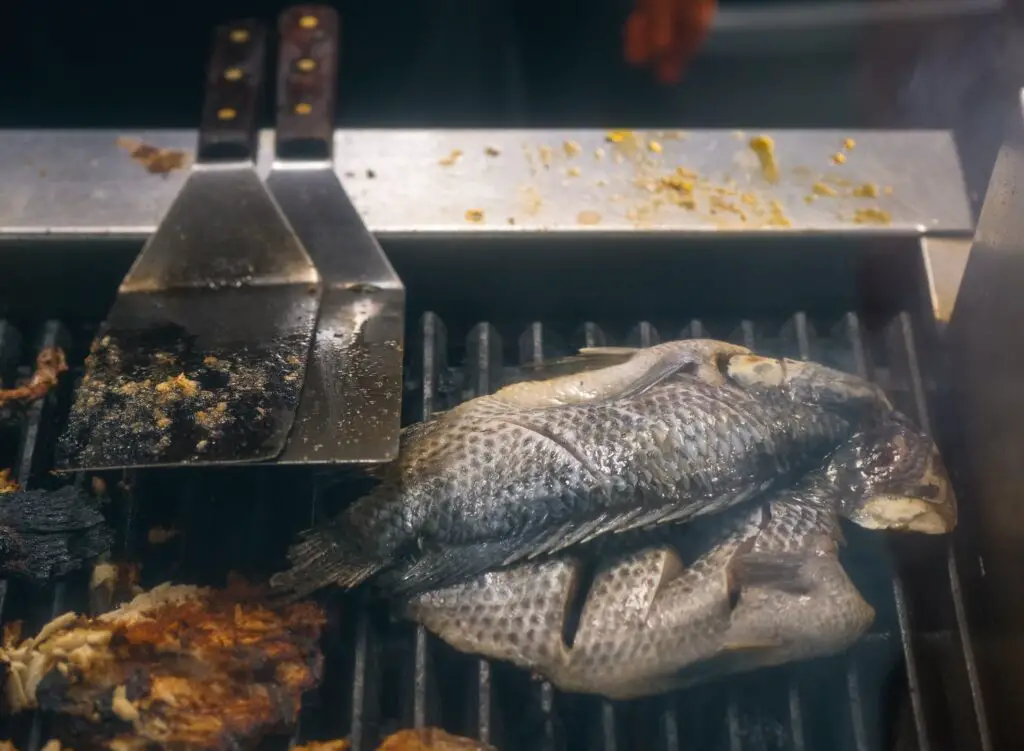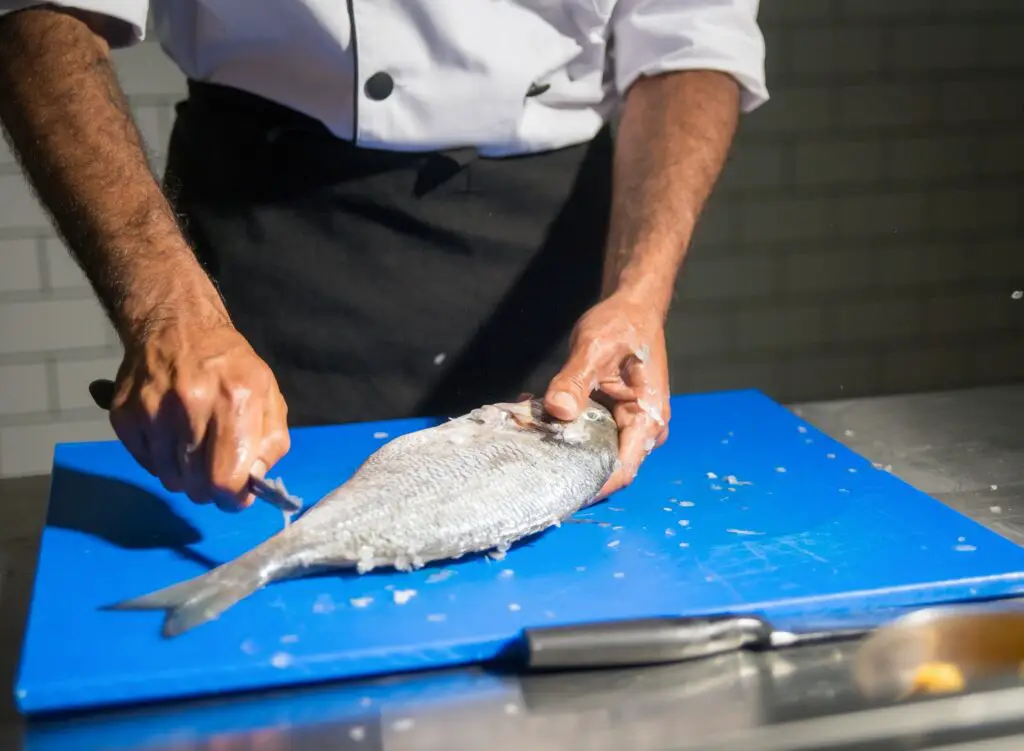Some links on this page may contain affiliate links which means that, if you choose to make a purchase using the link, Agricfy.com may earn a small commission at no extra cost to you. For more information, go to our Affiliate Disclosure Page!
Introduction
The yummy taste and nutritious value of fish have made it one of the most sourced proteins.
Fish farming is a type of aquaculture in which fish are reared intensively or extensively for commercial purposes.
Fish farming involves the rearing or breeding of various types of fish on a large scale.
The most commonly reared fish are salmon, tilapia, and catfish.
And tilapia is top on this list.
Tilapia farming is one of the most profitable farming businesses that has become popular over time.
Many farmers choose to grow the tilapia in freshwater, some in marine water, or in ponds.
Whichever habitat, tilapia sure has lots of benefits.
There are different types of tilapia fish, but the most common types are the Nile tilapia, blue tilapia, and Mozambique tilapia.
What Is A Tilapia Fish?

Tilapia is a common name given to more than a hundred varieties of fish.
Tilapia is not found in wild waters but in freshwater.
It has lots of health benefits and economic value.
Tilapia is rich in protein, phosphorus, potassium, niacin, and vitamin B-12.
It also contains low-fat saturated fat, omega-3 fatty acids, carbohydrates, and calories.
According to Thomas Parma’s publication by the Southern Regional Agricultural Center, “the harvest of farmed tilapia is now more than 800,000 metric tons and tilapia is the most popularly farmed fish in the whole world.”
- Tilapia is not just one fish but a common name for different types of CiChlid fish.
- Tilapia existed more than 3000 years ago.
- Tilapia is a deep-bodied fish covered in scales with long fins.
- It has spines in the pelvic and anal regions.
- Tilapia is a freshwater fish that belongs to the cichlid family.
- It is mostly farmed in Africa, though it is widely eaten in other countries as well.
- In fact, China is known to be the best producer of tilapia fish.
- The tilapia fish grows very fast and is highly nutritious.
- It is disease resistant and can be raised in ponds constructed locally.
- The tilapia fish is a great commercial being that is lucrative and profitable.
- Tilapia has the longevity of life and can live up to ten years.
Types of Tilapia Fish
Tilapia fish, like other aquatic animals, come in a variety of sizes.
They are different in size, color, shape, characteristics, and species.
Though tilapia has different species, there are three major types of tilapia fish.
Which are the Nile tilapia, Blue tilapia, and Mozambique tilapia.
Nile Tilapia
This species dates back to Ancient Egypt, 3000 years ago.
It was used as a religious symbol.
It is also known as “St. Peter’s fish.”
This is a biblical allusion to the book of Matthew, where Peter, a disciple of Jesus, caught a fish with a coin in its mouth.
The Nile Tilapia is deep-bodied but has a smaller shape, more like it is compressed.
It is brownish in color and has a vertical tail.
The Nile Tilapia lives in shallow water with lower temperatures and has lived for more than ten years.
The Nile Tilapia grows and reproduces much faster than other types of tilapia.
The Nile tilapia reproduces very fast and in large numbers.
It is an omnivorous species and lives in not too deep water.
It feeds on aquatic plants, algae, and other aquatic organisms.
The Nile starts reproducing at 5 to 6 months.
The male marks a territory for itself and hatches a female egg.
This process is called spawning.
What is Spawning?
This process brings about the fertilization of mature female eggs.
Spawning is the eggs and sperm that the tilapia fish lay and deposit into the natural habitats of the tilapia fish.
When these eggs or sperm are released, the male tilapia covers the territory until fertilization occurs.
The tilapia undergoes two types of spawning: either mouth-brooding spawning or substrate spawning.
The Nile tilapia, Mozambique tilapia, and blue tilapia are mouthbrooders because their male and female species exhibit a synchronized relationship during fertilization, preventing other male tilapia from coming close to the female eggs.
The females lay their eggs in nests, then when fertilized, pick them up with their mouths and keep them until they hatch.
- The Nile spawns every 30 days.
- The eggs hatch after 5 to 7 days.
- A female can now carry up to 200 eggs.
- It grows up to two pounds in six to seven months.
Blue Tilapia
This tilapia is mostly farmed in sub-tropical Africa.
It is also called the “Israel tilapia” and has been in existence since 1864.
This type of tilapia has about 15–16 dorsal spines and has no stripes, unlike the Nile Tilapia, which has dark stripes.
It has lighter grey-bluish color.
The blue tilapia species grow very fast in the first few months.
They weigh an average of 5 to 6 pounds before age six.
Most of the time, the males grow larger than the females.
Mozambique Tilapia
Neotropical Biology and conservation affirms that Mozambique has been in existence since 1852 in southern eastern countries, especially areas surrounded by coastal waters like
Malawi, Mozambique, Zambia, and Zimbabwe.
Like the Nile tilapia, the Mozambique tilapia is deep-bodied and compressed.
It has spines on the frontal part of its body and long dorsal fins.
When placed in a natural habitat, it can live for up to ten years or more.
The Mozambique tilapia adapts easily to changing environmental conditions.
It can survive in marine water but does better in freshwater.
Apart from naturally produced tilapia, some tilapia are genetically farmed.
This type is popularly known as the “Gift,” a genetically improved farm tilapia.
In this category, it is the Red Tilapia.
- The red tilapia is found in South Africa and farmed in Indonesia.
- It is popularly called the Redbreast Kurper.
- This is bigger than the other three types.
- It has high economic value.
- It is reddish in colour and covered in scales.
- It is highly nutritious and yields a quicker harvest.
- It is also very easy to farm and yields a higher income for small-scale farmers.
Anyone going into tilapia fish farming can raise the tilapias in a tank, pond, or freshwater.
The tank or pond must :
- Have good water quality and temperature.
- Give the tilapia balanced food.
- Check it regularly for diseases or infections.
- Incorporate the filtration technology. This will enable you to have high quality and healthy fish, especially if you do not have the chance or time to replace their water daily.
No matter the type of tilapia fish, each needs lots of care and attention.
Every basic need of the tilapia should be met, whether it is reared in a freshwater tank or pond.
These basic needs include purified water, lights, food, and enough space to swim.
Every type of tilapia needs clean water in the fort.
The water should be room temperature and safe for human consumption.
They don’t drink water, rather their skin absorbs water and its nutrients.
Dirty water will destroy the tilapia’s immune system and make them prone to diseases and infection.
Tilapias don’t do well in darkness; they enjoy swimming towards any ray of light.
They enjoy swimming towards any kind of light.
Build the tank or pond in a way that sun rays can penetrate through.
Benefits of Eating Tilapia Fish

The benefit of eating Tilapia fish are:
- It is rich in protein.
- Low in fat and calories.
- It is affordable and easy to prepare.
- According to the Department of Agriculture (Everyday health), tilapia has about
i. 101 grams of protein
ii. 1 gram of total fat,
iii. 1 g saturated fat and no carbohydrates. No fibre, no sugar.
Again, tilapia is recommended by the American Heart Association for fighting heart disease.
This is because it contains a high dose of omega-3 fatty acids, which reduces the risk of heart infection.
Conclusion
Tilapia fish is so delicious and nutritious.
Needless to say, it is the most popular fish in the whole world.
It is a good source of protein and contains omega-3 fatty acids that help the body fight diseases.
It is very easy to farm, especially on a small scale.
Commercial tilapia farming yields a high income and is quite easy to start.
But you have to opt for the best types of tilapia to get a good profit.
Among the types of tilapia, the best and most farmed is the Nile tilapia.
Despite how good tilapia fish farming is, there are lots of factors that can affect its growth rate.
The advantage or disadvantage of tilapia fish farming depends largely on the farming practices, environmental exposure, location, and management method.
Food, water, oxygen supply, and moderate weather all play a role in the growth of tilapia fish, regardless of species.
There are several cooking methods that can be used to enjoy the delicious taste of Tilapia fish.
You can grill, smoke, dry, poach, steam, stir fry, or cure.
You can grill tilapia with butter or make barbeque with it.
Wow, so yummy!
More So, of all fishes, Tilapia is considered safe for children and pregnant women.
If you ever have the thought of starting a tilapia fish farm, then this article is the best you could read to prepare your mind about what is required.



[…] Reference – agricfy.com […]